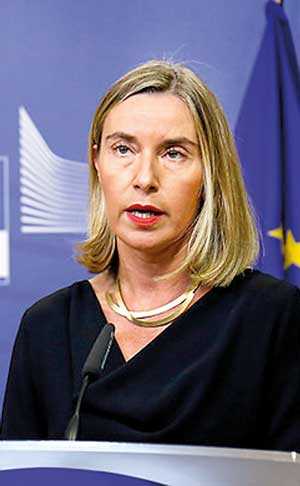Tuesday Dec 09, 2025
Tuesday Dec 09, 2025
Tuesday, 2 October 2018 00:00 - - {{hitsCtrl.values.hits}}
By Federica Mogherini
Europe and Asia have a centuries-old common history. The ties between the two continents are today reaching an unprecedented level. Asian markets account for over one-third of exports from the European Union. Almost half of the goods and services imported by the EU come from Asian countries.
Every year, thousands of students, academics, researchers move between the EU and Asia. The cultural exchanges between our cities are vibrant. And there is more to our mutual relationship than just economic or scientific exchanges: the European Union and Asian countries have a common interest in preserving a cooperative, rules-based and peaceful international system, where multilateral organisations are the natural fora for reaching common solutions.
This relationship needs to rely on effective, functioning and sustainable connectivity, in other words on the physical and non-physical infrastructure through which goods, services, ideas and people can flow unhindered.
While connectivity has always been a part of the EU’s policy towards Asia, until now the EU has not used its potential in this area to the full. That is why we have recently proposed a new policy framework to step up the EU action, an EU strategy on connectivity between Europe and Asia.
Our message is clear: the European Union is ready to step up its engagement with Asian partners on an agenda for connectivity, based on mutual interests and common objectives. Connectivity is in the very DNA of the European Union, as a political project based on market integration. We can offer our regulatory experience, technical expertise and funding opportunities at the service of projects that help interoperability and convergence, promote fiscally and environmentally sound growth, and strengthen our connections in a way that will be beneficial for us all.
We can do this in three ways. Firstly, the EU is ready to support new connections and networks between Europe and Asia. For example, extending our Trans-European Transport Network, which facilitates trade and mobility through removing technical and regulatory barriers for transport networks and modernising infrastructure to other non-EU countries would be a positive step. We will also pursue a sustainable digital agenda with Asia in order to foster universal and affordable access to digital technologies and services. We will share our experience in creating regional, liberalised energy markets with a focus on market-driven transformation towards clean energy. And we will continue to promote human exchanges and mobility through programmes such as Erasmus or the Marie Curie Action as a way to build connections, mutual understanding and share ideas.
Secondly, in the EU approach, connectivity can only be built in partnership. Many such partnerships exist already. The European Union supported the development of Sri Lanka’s National Export Strategy, vital to its trade infrastructure, to consolidate and expand the country’s reach in the region and the EU – its largest export market. The strategy will help Sri Lanka maximise the use of the GSP+ scheme granted in May 2017, which fully removed duties on 66% of tariff lines, covering a wide array of products including textiles and fisheries. But partnership is also more than trade. Thousands of Sri Lankan students travel to Europe each year for their higher education, while hundreds of thousands of Europeans travel to Sri Lanka every year as tourists. We can do even more to grow these numbers in a sustainable and mutually-beneficial way.
We will also work hand in hand with regional organisations and mechanisms existing in Asia, such as ASEAN, to identify and support projects. We want to work on a connectivity based on shared principles: transparency, non-discriminatory market practices, a level playing field for economic operators, protection for intellectual property rights. The best way to achieve this is not to impose anyone’s standards or rules, but to work together within international organisations on mutually acceptable ones. European companies must have a level playing field vis-à-vis their competitors and have the same access to markets abroad as others have in the EU.
Finally, we will mobilise all our levers to back projects with adequate funding, using to the full the potential of the European Investment Bank and of the new tools for external investment policy available under the EU budget. According to the Asia Development Bank, Asia will require over €1.3 trillion a year of infrastructure investment in the coming decades.
The EU is ready to support Asian countries meet such an investment challenge leveraging public and private financing through a combination of grants, guarantees, lending and blending. Yet, investment must be fiscally viable and financially sustainable. The EU will only support projects that mobilise domestic resources, create value for local communities and are sustainable in the long term.
Together, Europe and Asia account for almost 70% of global population and over 60% of the world’s GDP. There is space for making our ties stronger and more mutually beneficial. Sustainable connectivity, based on strong partnerships and transparent rules, is for the EU, European and Asian countries, the best way forward.
(The writer is High Representative of the European Union for Foreign Affairs and Security Policy and Vice-President of the European Commission.)